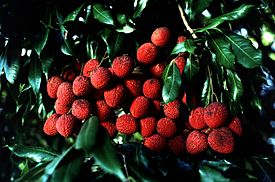Lancetilla Botanical Garden facts for kids
Quick facts for kids Lancetilla Botanical Garden & Research Center |
|
|---|---|

Lychee tree with its fruits.
|
|
| Area | 1681 ha |
| Created | 1925 |
The Lancetilla Botanical Garden is a special place where many different plants grow. It's a big tourist spot located on the Caribbean Sea coast in northern Honduras. You can find it about 7 kilometers (about 4 miles) southeast of the city of Tela.
Contents
What is the Lancetilla Garden?
For a long time, the Lancetilla Botanical Garden was the only one of its kind in Honduras. It's also one of the biggest botanical gardens in all of Latin America. This garden is part of the National School of Forest Sciences (ESNACIFOR), which means it helps teach people about forests.
The garden is also part of a group called BGCI, which works to protect plants around the world. Its special code for botanical institutions is LANCE.
Exploring the Garden's Plants
The Lancetilla Botanical Garden covers a huge area of 1,681 hectares (about 4,154 acres). This includes a nature reserve, special plant areas, and an arboretum. The garden has about 1,500 different types of plants, mostly tropical fruit plants.
The Arboretum
The arboretum is a 70-hectare (about 173-acre) section of the garden. It's like a living museum of trees, with over 1,500 different kinds. Most of these are fruit trees and timber trees from tropical places all over the world.
The Nature Reserve
A large part of the garden, about 1,200 hectares (about 2,965 acres), is a protected forest. This area is called the Nature Reserve and is located in the Lancetilla River basin. It's very important because it helps supply water to the city of Tela. This forest has been kept safe and is still being protected today.
Experimental Plantations
The garden also has 350 hectares (about 865 acres) of experimental plantations. Back in the 1930s, many trees were planted here, like Mahogany (Swietenia macrophylla), Teak (Tectona grandis), and White teak (Gmelina arborea). Today, about 100 hectares of these old plantations still exist in the botanical garden. They are used as "seed trees," which means their seeds are collected to grow new trees.
Special Plant Collections
The Lancetilla Garden is famous for its amazing collections of specific plants:
- Banana Collection: This garden has one of the richest and most diverse collections of banana plants in the world!
- Asian Fruit Trees: You can find 636 different kinds of fruit trees from Asia here. They belong to 392 different groups (genera) and 107 families. Some cool examples include Mangosteen (Garcinia mangostana), Lychee (Litchi chinensis), Rambutan (Nephelium lappaceum), and Mango (Mangifera indica).
- Palm Collection: The garden also has a great collection of palm trees, like the African oil palm (Elaeis guineensis) and the royal palm (Roystonea regia).
- Orchid Collection: Discover many beautiful orchids.
- Bamboo Collection: See different types of bamboo plants.
About 200 hectares of these plantations are used for different studies by the "National School of Forest Sciences."
What Else Can You Find?
The Lancetilla Botanical Garden has several buildings for offices and research. Many of these buildings still look like they did in the 1930s and 1940s. This was when the garden was owned by a banana company called the United Fruit Company.
You can also find a Herbarium here. A herbarium is like a library of dried plant samples from the area. If you get hungry, there's a cafeteria with a restaurant. The garden also has places to stay for up to 30 people.
See also
- Lancetilla
- Haptanthus
- In Spanish: Jardín botánico Lancetilla para niños

